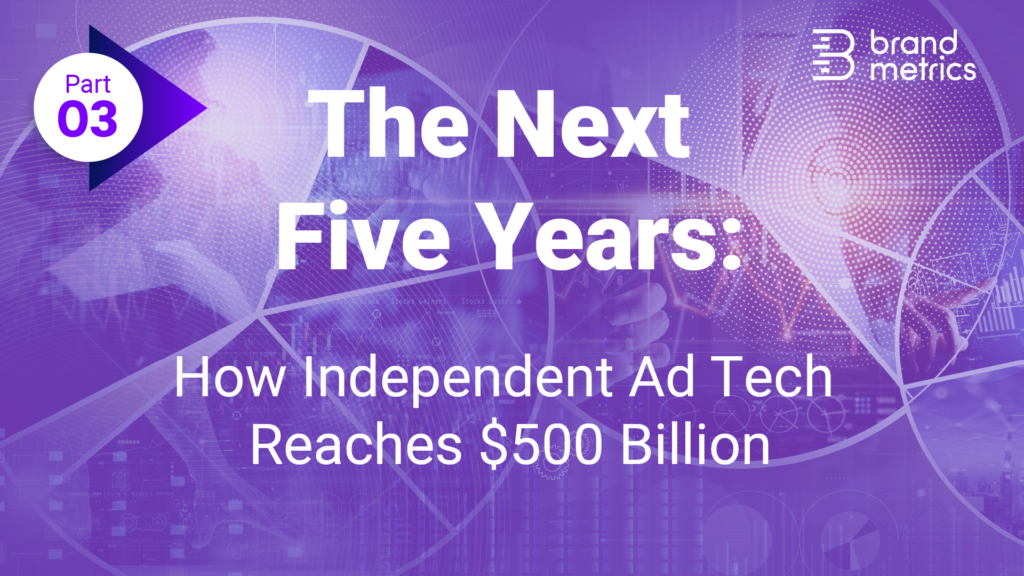By Tom Jenen, chief revenue officer, Brand Metrics
For independent ad tech to continue its booming growth over the next five years, it is essential that there is plenty of disruption – and the world today would seem to guarantee us that, if nothing else.
In my last column, I outlined the likely sources of that disruption, including data privacy, the macroeconomy, the likely (?) recession and moves by the global monopoly platforms. But alongside those predictable disruptions, we also see the new green shoots of sector growth, which are pulling in massive investments from both VC and private equity partners, due to their oft-talked-about potential to drive huge returns. Here are three.
CTV/Streaming video
In 2017, eMarketer estimated that CTV ad spending would reach $2.6 billion. This year, it will reach $18.9 billion, and will soar to $38.83 billion by 2026. (eMarketer)
I don’t think I need to speak too much to this opportunity as we’re all very aware of the promises made for the future of TV. I’ll only say that it’s still too early to call winners, because I expect everyone in ad tech will be winners.
Why? There are so many problems to be solved with our innovative, creative minds. The ecosystem is rife with ad fraud, there’s very little audience or campaign effectiveness measurement, the ad serving technology is basic, the combination of hardware, software, exchanges, networks and more adds layers of complexity – everything speaks to problems that need to be solved. Ad tech will fill the gap.
The Metaverse
Or Web3. Or AR/VR. Whatever you want to call it, we can’t ignore it. Like blockchain in the last decade, there is massive hype. Meta is pushing to “own the rails” by putting out incrementally-better but still problematic headsets, and Apple will set the standard when they put out one at an eye-watering price point. Microsoft is doing what Microsoft does, and making their huge gaming assets available for everyone to use in a play to be the software to that hardware. But from what I can see, the platforms today are immersive and even interoperable, much more than one might think. My avatar can traverse into other worlds, servers, companies. I can bring my items – think NFT-like versions of Nike shoes and Rolex watches – with me.
$100bn is reasonable as a total market valuation of the metaverse today, but most of that right now doesn’t relate directly to ad tech, but to e-commerce, which is critical. That means the metaverse is still a greenfield site for ad tech, and I know – especially given the number of exits we’ve seen over the last two years alone and the capital funnelled back to founders – that we will capitalise on it.
The winners in the metaverse seem set to include Microsoft/Activision, Fortnite, King Games, Zynga, MMO, Bidstack and Adverty.
Commerce Media, including Retail Media Networks
Most retail businesses, both off and online, don’t carry advertising. Sure, they have partner programs and some affiliates, but those aren’t ad budgets – it just looks like ads. So, of course, most big retailers are considering how to get the ad budgets. And that brings us to what I call the Three Stages of Retail Media:
- Sell ads to your current customers on your own site(s). This is a massive step. It means getting an ad tech stack, which is easy, but it also means figuring out how to do it without letting Google and Amazon know all your data, which is not. And therein lies the opportunity. Build or buy? Google or independent? What’s a few million in tech investment when 40% media profit margins mean you have nine digits of potential? These are the new walled gardens.
- Sell ads to other advertisers on your own sites. This, again, is tricky because you have to start opening up your walled garden, but with the right tech and market position you can get buyers to open seats on your own DSP, or connect to your clean room, and start making more money.
- Sell ads to everyone on all sites, using your data as a value-add. Most retailers stop short before this stage, which is odd, because if you’ve done Stage 1 and 2, Stage 3 is where the revenue rocket really takes off. That’s right, you’ve built the rocket – you just haven’t fired it to the moon yet. But because retailers get comfortable with the new revenue and lose their appetite for risk, and because they just don’t think of themselves like media people, they stop.
I believe the appetite from marketers for retail media is actually unlimited, because it’s better data, better views on the consumers, and with tangible, attributable results. There’s an opportunity for independent ad tech, obviously, because we aren’t Google, and we can turn any retailer into their own little Amazon.
The winners in retail media are ad servers, clean rooms, ID solutions, programmatic service organisations and white label tech.
And when these big structural changes occur, the rest of the ecosystem needs to evolve as well, including measurement, verification, analytics and optimisation.
A formula for growth
And – to return to my original hypothesis – in amongst these growth areas, the existing sectors subject to major disruption, the mergers and acquisitions and the organic growth, I believe we may well have here the formula for an independent ad tech market that hits a valuation of $500bn in the next few years. Of course, there are no guarantees, but one way or another, exciting times are coming.









